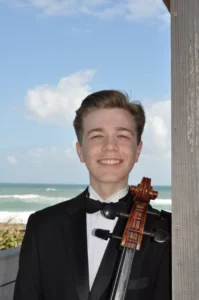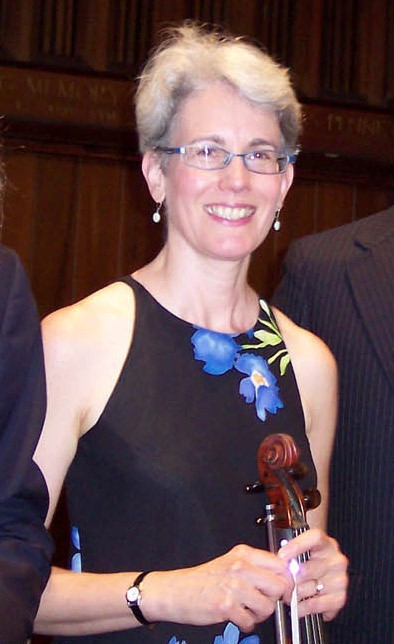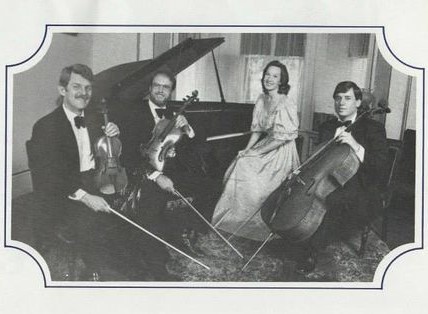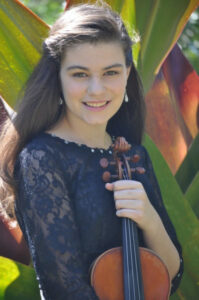PIANO & STRINGS – Ensemble
Brooke Gunter, violin
Piano Trios:
Amore per il mare (Love of the Sea) – 7’00. The work reflects a life spent near large bodies of water. I grew up in the United States along the shores of Lake Erie, one of the Great Lakes, and spent most of my childhood in or on the water. The area included many islands, as well as marshes and the large, shallow Sandusky Bay. As an adult, I moved to the coast of North Carolina, again near large and varied bodies of water. The sea and its environs have always fascinated me. The weather is so variable and the sea, so capricious. In this work, I have tried to capture that sense of excitement and joy I associate with adventure on the water.
Live performance. The work was premiered on October 9, 2018, as part of the Sunset Concerts at the Gallery in Stuart, Florida, by Brooke Gunter, violin, Brandon Gunter, cello, and Marie Jureit-Beamish, piano.

Brandon Gunter, cello.
The Gunter Trio also contained another sibling, Ava Gunter, on violin or viola, all very talented young musicians.
Piano Trio (revised 2017) – 18’30”. The first movement begins with a certain amount of mock charm and sophistication created by a turn on the initial upbeat. This is the beginning of a seven-part rondo with a brief coda. The slow movement begins with sustained chords against fragments from the cello. When the cello introduces a sustained, plaintive melody, the opening fragments become the counter melody. The third movement is akin to a scherzo and trio, both in terms of sections (although not repeated) and light-hearted content. It begins quietly with driving rhythms. The fourth movement is a version of an earlier work, Amore per il mare (Love of the Sea). It begins cheerfully with rising arpeggios from the piano leading to a sunny melody introduced by the strings. MIDI recording.
Partridges Among the Sitka Spruce (2010) for violin, viola and piano – 14’50”. Written for my good friends, Hugh and Margaret Partridge, the title becomes a joke, but the piece is quite serious. It opens with “Vast Forests,” a movement that is noble and expansive. “Down Home, Down East” is a bluesy connection to eastern North Carolina, my home for many years. The work concludes with “It All Goes South,” a lively, jazzy movement full of high spirits.
Live performance. Premiered by Margaret Partridge, violin, Hugh Partridge, viola, and Dr. James Schmidt, piano.

Margaret Partridge, violin
Piano Quartets:
First Stanzas of William Blake (10/12/21) for Piano Quartet – 14’00”. This work was inspired by William Blake’s poetry. I. Introduction to the Songs of Experience – The movement is composed of several elements – upward leaps of ninths and sevenths, running sixteenth notes, a rhythm of two eighths rest eighth, and sequentially falling chord patterns. II. The Lamb – The movement features a violin solo over a rising sixteenth-note accompaniment. III. The Tyger – The movement features both the piano and the viola. Its fast pace is interrupted by a middle section like a slow, smoky blues from the 1930s. MIDI recording.
1902 (7/16/17) for piano quartet – 10’30”. This virtuosic piece explores both the pride and the potential difficulties of living a life with honor. Its beginning is march-like and proud, but the middle sections reflect self-doubt and hard decisions. MIDI recording.
Flos aetatis vita in media (11/15/16) for piano quartet – 17’00”. The title translates roughly as “the flower of time, in life’s middle.” There are four movements. The first presents a contrast between the descending sixteenth-notes first heard in the upper string parts and the more lyrical cello melody. Later, a rising figure is added, creating a more positive mood that is echoed in the less dissonant return of the cello melody. The second movement is a reworking of my song setting of the sonnet “How do I love thee” by Elizabeth Barrett Browning. It is lush and lyrical. The third movement is dance-like and cheerful. The fourth begins with material that references the opening of the work, then moves to a jazzier idea. MIDI recording.
Living in the Moment (10/26/15) for piano quartet – 16’45”. The four movements create common feelings that reflect engagement in life. In “Fear of Success” one might imagine an act that one knows will meet a goal and cause positive change. However, change can be a scary thing, and it is that dilemma that drives the emotional workings of the movement. “Over the Top” is a traditional scherzo creating a fearless drive that allows no resistance. “Into the Depths” is largely a piano solo accompanied by the string trio. It is both somber and contemplative. “Unbridled Cheerfulness” returns to the spirit of the earlier scherzo, even employing some of the same melodic material. It is a dance of the spirit, full of hope and the joy of life. MIDI recording.
Fugal Dreams and Vivid Memories (10/5/14) for piano quartet – 13’30”. Although there is a fugue in each of the first two movements, the work is really about the nature of memory. Memories tend jumble over time unless they were created by a strong emotional circumstance. The driving rhythms of the opening movement give way to a three-part fugue with minimal piano accompaniment. Here, memory becomes unclear over time. The adagio beginning with a three-part fugue in the strings has extended episodes including the piano. Here, memory becomes clearer over time. The rousing energy of the finale gives rise to the idea that this is a vivid memory. The inclusion of a jazzy piano makes this the most memorable movement in the work. MIDI recording.
Emerging Spring (10/2/13) for piano quartet – 15’40”. The four movements of Emerging Spring evoke a sense of renewal as well as images of spring. “March Lions and April Lambs” focuses on the variable weather in early spring. There are rough winds as well as beautifully clear, calm days and the promise of warm days to come. “May Apples Dance” was inspired by the May Apple, a short, humble woodland plant with a single, apple-like fruit. In a strong wind they can appear to dance about. “Trillium, Trillii?” is a title that is intended rhetorically. What is the plural for trillium? The movement itself is more serious. The trillium is a beautiful woodland plant with three leaves surrounding a red-wine flower. It is a wonderfully peaceful creation. “June is Bustin’ Out” explores the overwhelming greenery that bursts forth in June. It is like a physical assault on the senses, a profusion of new plant life that cannot be denied. MIDI recording.
Second Piano Quartet: Mountain Life (2012) – 13’30”. I conceived of this work as a programmatic portrait of the four seasons of the year. The movements reflect both the physical beauty and human strength needed for life in the mountains. The first movement begins with unsettled winter weather. Throughout this section, the cello appears to revel in the confusion, offering a slow, solid melody underneath the fury of the storm. The second movement reflects the beauty of spring and a sense of the loneliness it can cause. The opening theme emerges slowly, almost secretly, as a single melody joining voices with others. When the piano begins a rhythmic ostinato accompaniment, the upper voices create a celebratory hymn to the return of spring. The third movement is a dance, an entertainment in fresh air and summery conditions. It is light and lively and follows a sectional form with rondo-like qualities. The finale is dramatic and powerful, suggesting the return of autumn storms. It relies on dense chords to create the dramatic tension of the piano’s opening statement. Repeated staccato pitches underly wispy triplets that suggest the play of wind in brightly colored leaves. Meanwhile, the piano continues its chordal assault in shorter rhythms. MIDI recording.

The Energies of Adam (1984) for piano quartet – 19’00”. I wrote these four movements to honor my thirteen-year-old son. “Flashy/Exuberant” reflects the cocky energy with which he faced each day. He was self-confident and sure of himself. At the same time, he was often “Moody/Melancholy,” able to spend hours in his room brooding over perceived mistreatments. His sense of humor and mischief is evident in “Wistful/Playful.” And his determination to succeed on his own terms made “Self-Possessed” the logical finale. I am happy to say that he is now a successful English teacher and soccer coach.
Live recording. Premiered by the NewOld Quartet: Paul Gorski, violin, Hugh Partridge, viola, Michael Stoughton, cello, and Lydia Gatling Barden, piano, in 1984.
The NewOld Quartet
Piano Quintet:
Raleigh Weekend, Piano Quintet, (2000) – 22’10”. Here is a work named after a city near where I lived at the time, but any big city would offer similar opportunities. The four movements represent a science museum – Brimley’s Chorus Frogs, an arboretum – Maize at the Edge of New Dawn, an art museum – The Burghers of Calais, and a symphony concert – Percussive Woman.
Live performance. Premiered by the NewOld Trio with Marjorie Rahima Holstein, piano, on January 12, 2001, at Coastal Carolina Community College, Jacksonville, NC.
.

Marjorie Rahima Holstein, piano, was my colleague at Coastal Carolina Community College at the time Raleigh Weekend premiered.
